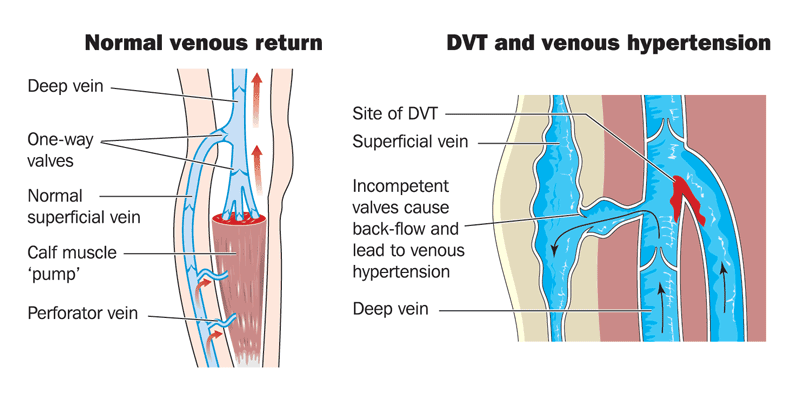Vein diseases of any kind can be very scary. After all, the circulatory system runs constantly and requires unhindered operation to run smoothly! Deep vein thrombosis may be the most serious type of vein disease; it can significantly disrupt the basic functions of the circulatory system, sometimes resulting in a life-threatening pulmonary embolism and even death.
Since it is so serious, it’s understandable to have lots of questions about deep vein thrombosis, also known as DVT. Here’s what you need to know about DVT and how it should be treated.
 Deep Vein Thrombosis: What is it?
Deep Vein Thrombosis: What is it?
Deep vein thrombosis, or DVT, is a blood clot that forms in a vein deep within the body. DVT most commonly occurs in the lower leg and the thigh. This happens when the vein is damaged (after a fall or surgery, for example) or when the blood slows down or stops. This is big problem because your veins carry blood back to the lungs for re-oxygenation— a clot puts a real kink in this process.
Why does this matter? Well, a DVT can have serious consequences. Parts of a blood clot can break off and travel to the lungs, blocking blood flow to the lungs and resulting in a pulmonary embolism, which can be fatal.
Causes of Deep Vein Thrombosis
There are many reasons that a deep venous clot can occur. For example, increasing age, family or personal history, and existence of vein diseases like varicose veins can all cause a DVT to form. Some forms of malignant cancers can also increase the risk of a DVT.
While you can’t alter your family history, stop time, or reverse damage from vein disease, there are some causes that are very preventable. Smoking is a major cause for DVT, and for women, the use of hormonal birth control or hormone replacement therapy can increase your risk of developing a clot.
Smoking while on birth control or hormone replacement therapy is firmly discouraged; it even further increases the risks. Pregnancy can also add to the risk factors, because of the changes in hormone levels and the physical changes a woman’s body undergoes during pregnancy.
Additionally, being overweight or inactive can heighten a person’s chance of developing a DVT. Inactivity can lead to DVT in a matter of hours. Long airline flights are a prime environment for clots to form. Surgery, especially to the hips and legs, can result in a DVT as well due to the damage to the body, the clotting that occurs after an incision, and the tendency for inactivity during recovery time.
Know the Symptoms of DVT
There are several telltale signs of a deep blood clot or DVT, but that doesn’t mean the symptoms always exhibit themselves. Some people may see few to no warning signs until they experience a pulmonary embolism.
That said, be on the lookout for any symptoms, including swelling and tenderness of the area as well as distended veins. The skin may also become discolored, and veins may thicken or firm up, forming what is known as a cord.
If you are experiencing a pulmonary embolism, the symptoms are much more obvious. This problem is more immediate, as the clot blocks blood flow to the lungs or heart. Shortness of breath, sudden chest pain, coughing, and spitting or vomiting blood are all signs of an active pulmonary embolism.
Treating a DVT Blood Clot
Clots can be diagnosed by ultrasound or by MRI. When they occur, the goal is to prevent them from getting bigger or breaking off and traveling through the bloodstream to the lungs. Anticoagulants and blood thinners may be prescribed, to keep a clot from worsening and to break it down slowly, and moist heat, elevation, and compression can also help treat a clot and promote circulation.
Sometimes, if a clot is not breaking down, additional treatments are called for. Catheter-directed thrombolysis is necessary from time to time. It uses strategically placed catheters to guide special medication to break down the clot.
Occasionally, surgical procedures are required, particularly if a clot just isn’t breaking off or if it poses a great risk for pulmonary embolism. This usually means that a filter is placed in the inferior vena cava—a large vein in the abdomen— to filter the blood and trap large clots that could lead to a pulmonary embolism.
Gradual reactivation and movement helps to get the blood flowing again and prevents additional clotting; this sometimes happens with a continuous passive movement machine, which can animate limbs even during sleep to decrease swelling and improve circulation. Compression socks are also helpful in this process, ensuring that the blood is properly flowing at all times.
Have more concerns about deep vein thrombosis, or want to speak to a professional? Contact us today at Johnson Memorial Health Wound Healing Center for sound, professional guidance and easy to understand answers so you can put your worries at ease and get back to your life.

